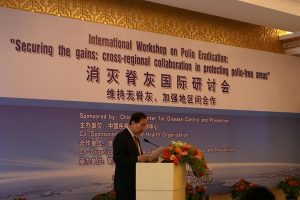Securing the gains: cross-regional collaboration in protecting polio-free areas
WHO and the CDC, China co-hosted an International workshop on polio eradication during 21-22 July in Urumqi, Xinjiang, China.

“The global battle to eradicate polio is challenged with the double pressure of being polio-free and maintaining polio-free status. This is the global scenario why this workshop is convened. We share a same mission, that is how to strengthen regional collaboration and accelerate polio eradication.” So said Dr WANG Ju, Director General of the Chinese Centre for Disease Control and Prevention (China CDC), at the opening of an international workshop on polio eradication on 21-22 July in Urumqi, Xinjiang, China. The event was co-hosted by China CDC and the World Health Organization (WHO).
This statement was echoed by more than 40 international public health specialists, senior officials and experts engaged in the field of polio eradication, from China, India, Myanmar, Vietnam, Pakistan, Nepal, Tajikistan, Russian Federation, Kazakhstan, Kyrgyzstan, Mongolia, Uzbekistan and WHO headquarter, European Region, South East Asia Region and Western Pacific Region, as well as partner agencies.
Although there are many very encouraging break-through developments in global polio eradication, with only 232 polio cases reported in the four endemic countries in 2010 and the Western Pacific Region certified polio-free status for a decade, the polio outbreak in Tajikistan in 2010 was a wake-up call on this unfinished business. Neighbouring countries such as Mongolia and China came under the threat of the virus travelling across borders.
“The poliovirus is a dangerous foe and does not recognize international borders. We need intercountry and interregional collaboration for the best possible surveillance and immunization activities,” said Dr Shin Young-soo, WHO Regional Director for the Western Pacific, in his video speech addressing the delegates. “As long as there is polio anywhere in the world, any child who has not been fully vaccinated is vulnerable”.
Recognizing polio eradication is a global activity and an ongoing process and certification of polio-free status is not a guarantee, meeting participants summarized five major lessons learned in 2010.
- Importations occur all the time and will continue until polio eradication is reached.
- The most vulnerable populations will be affected the most. Reported immunization coverage may not always represent true childhood population immunity. Even if accurate, subnational variation is what matters—“the weakest link”.
- Rapid response is vital—delays mean any outbreak could be catastrophic in size and fatal. It requires sensitive surveillance at all critical subnational levels. Every step in acute flaccid paralysis (AFP) surveillance needs to be timely. Early notification of suspicion is best.
- Response to threat requires full political support. Cross-border coordination and cooperation is critical.
- Outbreaks are much less expensive to prevent than control and interrupt. Risk assessment should be undertaken by countries and provinces and should lead to risk reduction. Funding prevention requires local mobilization.
In a time of increasing globalization, infectious disease control efforts cannot focus just on the domestic situation. Working together to optimize early detection and response capacities is key to protect those areas that are polio-free and to prevent the risk of a major outbreak.
Meeting participants agreed that it is important to define and develop mechanism to share timely information and data, for example, national and subnational coverage and surveillance data, subnational risk assessments in “bordering” geographic areas, and plans for immunization campaigns.
Workshop participants realized that strategies to immunize cross-border migrant populations are needed. It is critical to support each other with emergency vaccine needs, where possible. And where appropriate and feasible, it is good to combine risk assessments and use them for joint advocacy and resource mobilization efforts.
Infectious viruses do not recognize international borders. Wild poliovirus is no different. Countries should share solutions to common problems. Joint political commitments are encouraged. All levels are vital. Without support at a number of different stages, and overall coordination, the efforts of reaching the last hidden child would have been impossible.
Meeting participants also discussed cross-regional collaboration through professional travel exchanges of staff, delivery of training workshops, online collaboration, and resource sharing. Future meetings between polio-infected countries and workshops with all countries are also anticipated.
The world cannot contain polio- it must be eradicated, meeting participants vowed. “Let’s find new ways of working together and supporting each other to ensure that no child, anywhere in the world, will ever again suffer the pain of lifelong polio paralysis,” concluded Dr Shin.














